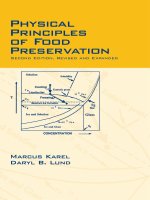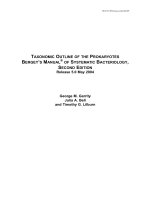Elements of environmental chemistry second edition
Bạn đang xem bản rút gọn của tài liệu. Xem và tải ngay bản đầy đủ của tài liệu tại đây (4.67 MB, 346 trang )
ELEMENTS OF
ENVIRONMENTAL
CHEMISTRY
A Note on the Cover
The illustrations on the cover represent the four "elements" in an environmental chemist's periodic table:
air, earth, fire, and water. The images were taken by J.
D. Raff and show clouds over the Pacific Ocean (air), a
mesa near Capitol Reef National Park, Utah (earth),
wildfire smoke obscuring the sun (fire), and ripples in
the Pacific Ocean near Monterey Bay, California (water). This bit of whimsy was suggested by a Sidney
Harris cartoon appearing in his book What's So Funny
About Science? (William Kaufmann, Los Altos, CA.
1977). A full periodic table is given in Appendix C.
ELEMENTS OF
ENVIRONMENTAL
CHEMISTRY
Second Edition
Ronald A. Hites
Jonathan D. Raff
School of Public and Environmental Affairs
Indiana University
WILEY
A JOHN WILEY & SONS, INC., PUBLICATION
Copyright © 2012 by John Wiley & Sons, Inc. All rights reserved
Published by John Wiley & Sons, Inc., Hoboken, New Jersey
Published simultaneously in Canada
No part of this publication may be reproduced, stored in a retrieval system, or
transmitted in any form or by any means, electronic, mechanical,
photocopying, recording, scanning, or otherwise, except as permitted under
Section 107 or 108 of the 1976 United States Copyright Act, without either the
prior written permission of the Publisher, or authorization through payment of
the appropriate per-copy fee to the Copyright Clearance Center, Inc., 222
Rosewood Drive, Danvers, MA 01923, (978) 750-8400, fax (978) 750-4470,
or on the web at www.copyright.com. Requests to the Publisher for permission
should be addressed to the Permissions Department, John Wiley & Sons, Inc.,
111 River Street, Hoboken, NJ 07030, (201) 748-6011, fax (201) 748-6008, or
online at />Limit of Liability/Disclaimer of Warranty: While the publisher and author
have used their best efforts in preparing this book, they make no
representations or warranties with respect to the accuracy or completeness of
the contents of this book and specifically disclaim any implied warranties of
merchantability or fitness for a particular purpose. No warranty may be
created or extended by sales representatives or written sales materials. The
advice and strategies contained herein may not be suitable for your situation.
You should consult with a professional where appropriate. Neither the
publisher nor author shall be liable for any loss of profit or any other
commercial damages, including but not limited to special, incidental,
consequential, or other damages.
For general information on our other products and services or for technical
support, please contact our Customer Care Department within the United
States at (800) 762-2974, outside the United States at (317) 572-3993 or fax
(317)572-4002.
Wiley also publishes its books in a variety of electronic formats. Some content
that appears in print may not be available in electronic formats. For more
information about Wiley products, visit our web site at www.wiley.com.
Library of Congress Cataloging-in-Publication Data:
Hites, R. A.
Elements of environmental chemistry / Ronald A. Hites and Jonathan D.
Raff.—2nd ed.
p. cm.
Includes index.
ISBN 978-1-118-04155-0 (pbk.)
1. Environmental chemistry. I. Raff, Jonathan D. II. Title.
TD193.H58 2012
577M4—dc23
2011046732
Printed in the United States of America.
10 9 8 7 6 5 4 3 2 1
To
Benjamin Atlee Hites
Gavin James Mahoney
Malte Thorben Raff
CONTENTS
1. Simple Tool Skills
1.1. Unit Conversions
1.2. Estimating
1.3. Ideal Gas Law
1.4. Stoichiometry
1.5. Problem Set
1
1
5
9
14
16
2. Mass Balance and Kinetics
2.1. Steady-State Mass Balance
2.2. Non-Steady-State Mass Balance
2.3. Chemical Kinetics
2.4. Problem Set
23
24
41
59
69
3. Atmospheric Chemistry
3.1. Atmospheric Structure
3.2. Light and Photochemistry
3.3. Atmospheric Oxidants
3.4. Kinetics of Atmospheric Reactions
3.5. Stratospheric Ozone
3.6. Smog
3.7. Problem Set
77
77
80
86
88
91
105
112
4. Climate Change
4.1. Historical Perspective
4.2. Blackbody Radiation and Earth's
Temperature
4.3. Absorption of Infrared Radiation
4.4. Greenhouse Effect
4.5. Earth's Radiative Balance
4.6. Aerosols and Clouds
4.7. Radiative Forcing
123
123
125
130
132
134
138
141
vii
viii
Contents
4.8. Global Warming Potentials
4.9. Concluding Remarks
4.10. Problem Set
142
144
146
5. Carbon Dioxide Equilibria
5.1. Pure Rain
5.2. Polluted Rain
5.3. Surface Water
5.4. Ocean Acidification
5.5. Problem Set
153
155
160
169
174
181
6. Pesticides, Mercury, and Lead
6.1. Pesticides
6.2. Mercury
6.3. Lead
6.4. Problem Set
189
191
210
213
217
7. Fates of Organic Compounds
7.1. Vapor Pressure
7.2. Water Solubility
7.3. Henry's Law Constant
7.4. Partition Coefficients
7.5. Lipophilicity
7.6. Bioaccumulation
7.7. Adsorption
7.8. Water-Air Transfer
7.9. Reactive Fates of Organics
7.10. Partitioning and Persistence
7.11. Problem Set
223
225
226
227
228
229
231
232
235
240
242
247
8. PCBs, Dioxins, and Flame Retardants
8.1. Polychlorinated Biphenyls (PCBs)
8.2. Polychlorinated Dibenzo-/?-dioxins and
Dibenzofurans
8.3. Brominated Flame Retardants
8.4. Lessons Learned
259
259
277
297
304
Contents
ix
A. Primer on Organic Structures and Names
307
B. Answers to the Problem Sets
325
C. Periodic Table of the Elements
328
Index
331
PREFACE
M
any chemistry and environmental science departments now feature a course on environmental
chemistry, and several textbooks support these courses.
The coverage and quality of these textbooks varies - in
some cases dramatically. Although it is obviously a
matter of opinion (depending on the instructor's background and skills), it seems to us that a good textbook
should be quantitative and should develop students'
skills with numerous real-world problems.
This book aims at a quantitative approach to environmental chemistry. In fact, one could think of this book
as providing the student with the essence of environmental chemistry and with a toolbox for solving problems. These skills are transferable to other fields beyond environmental chemistry. With effort, this book
will allow students to understand problem-solving
methods in the context of environmental chemistry and
provide basic concepts of environmental chemistry such
that these problem-solving skills can be used to understand even more complex environmental challenges.
This is a relatively short book. Its goal is to be tutorial
and informal; thus, the text features many quantitative
story problems (indicated by bold font). For each problem, a strategy is developed, and the solution is provided. Although short, this book is not intended to be read
quickly. It is an interactive textbook, and it is intended
XÍ
xi¡
Preface
to be read with a pencil in hand so that the reader can
follow the problem statement, the strategy for solving
the problem, and the calculations used in arriving at an
answer. "Reading" this book will do the student little
good without actually doing the problems. It is not sufficient for the student to say, "I could do that problem if
I really had to." The student must work out the problems if he or she is going to learn this material.
In addition to the problems in the text, each chapter
ends with a problem set. Besides reinforcing concepts
introduced in the chapter, we have tried to incorporate
issues from the scientific literature and from the "real
world" in these problem-set questions. The answers to
these questions are at the back of the book, and full solutions are in a Solution Manual available from the authors. Most of the problem sets include a problem that
requires a bit more time and the application of simple
computing; we have called these "Group Projects" to
encourage students to work together on these problems.
They could be assigned to small groups of students or
held back for the especially competent student.
As a stand-alone text, this book is suitable for a onesemester course (particularly if supplemented with a
few lectures on the instructor's favorite environmental
topics) aimed at upper-level undergraduate chemistry or
chemical engineering majors or at first-year graduate
students with only a modest physical science background. Because of its tutorial nature, this book would
also make a good self-study text for entry-level professionals. A little calculus will help the reader follow the
exposition in a few places, but it is hardly necessary.
Preface
xiii
The Second Edition has been completely revised and
rearranged. The former chapter on atmospheric chemistry has been divided into two new chapters: one on atmospheric chemistry and one on climate change. The
sequence of the chapters on chemodynamics and pesticides, lead, and mercury has been reversed. A descriptive chapter on polychlorinated biphenyls and dioxins
and polybrominated flame retardants has been added at
the end. A tutorial on organic chemistry names and
structures has been added as an appendix.
We thank Todd Royer and Jeffery White for their insightful comments on parts of the text. We also thank
the hundreds of students who used this material in our
classes over the years and who were not shy in explaining to us where the material was deficient. Nevertheless, errors likely remain, and we take full responsibility
for them. We also thank Robert Esposito, Executive
Editor at John Wiley & Sons, for guiding this project to
completion.
We would be happy to hear from you. If we have omitted your favorite topic, been singularly unclear about
something, or made an error with a problem set solution, please let us know.
Ronald A. Hites
Jonathan D. Raff
Bloomington, Indiana
October, 2011
Chapter 1
Simple Tool Skills
T
here are several little tasks that will occur over and
over again as we work through problems; we need
to master them first. These tasks include unit conversions, estimating, the ideal gas law, and stoichiometry.
1.1. UNIT CONVERSIONS
There are several important prefixes you should know:
Prefix
yocto
atto
femto
pico
nano
micro
milli
Abbreviation
y
a
f
P
n
μ
m
Multiplier
10-24
10-18
io- 15
io- 12
9
IO"
IO-6
IO"3
Prefix
centi
deci
kilo
mega
giga
tera
peta
Abbreviation
c
d
Multiplier
IO"2
IO"1
k
IO3
M
G
T
IO6
IO9
IO12
IO15
P
For example, a nanogram is 10 9 grams and a kilometer
is 103 meters.
For those of us forced by convention or national origin
to work with the so-called English units, there are some
other handy conversion factors you should know:
Elements of Environmental Chemistry, Second Edition
Ronald A. Hites, Jonathan D. Raff
© 2012 John Wiley & Sons, Inc. Published 2012 by John Wiley & Sons.
2 Elements of Environmental Chemistry
1 pound (lb) = 454 grams (g)
1 inch (in.) = 2.54 centimeters (cm)
12 inches = 1 foot (ft)
1 meter (m) - 3.28 ft
1 mile = 5280 ft = 1610 m
3.8 liter (L) - 1 U.S. gallon (gal)
There are some other common conversion factors that
link length units to more common volume and area
units:
1 L (liter) =10 3 cm3
1 m3=103L
1 km2 = (103m)2 - 106 m2 = 1010 cm2
One more unit conversion that we will find helpful is
1 tonne- 1 t = 1 0 3 kg =10 6 g
Yes, we will spell metric tonnes like this to distinguish
it from English tons, which are 2000 lbs and also called
"short tons." One English ton equals one short ton and
both equal 0.91 metric tonne.
Another unit that chemists use to describe distances between atoms in a molecule is the Angström,1 which has
the symbol Á and represents 10~10 meters. For example,
the C-H bond in an organic molecule is typically 1.1 Á,
or 1.1 x 10"10 meters. Likewise, the O-H bond in water
is only 0.96 Á long.
Let's do some simple unit conversion examples. The
point is to carry along the units as though they were al1
Anders Angström (1814-1874), Swedish physicist.
Simple Tool Skills 3
gebra and cancel out things
down your unit conversions!
the number of people who
meetings because they tried
their head.
as you go. Always write
We cannot begin to count
looked foolish at public
to do unit conversions in
Let's assume that human head hair grows at 0.5 in.
per month. How much hair grows in one second?
Please use metric units.
Strategy. Let's convert inches to meters and months to
seconds. Then depending on how small the result is, we
can select the right length units:
Rate =
0.5 in.
2.54 cm
I month
m
2
month J
10 cm
31 days
in.
\r
\f mm
· \
day
= 4.7xl0"ym/s
2Í~h V 60 min 60 s
If scientific notation is confusing, see footnote 2.
2
We will use scientific notation throughout this book because
it is easier to keep track of very big or very small numbers.
For example, in the calculation we just did, we would have
ended up with a growth rate of 0.0000000047 m/s in regular
notation; that number is difficult to read and prone to error
in transcription (you have to count the zeros accurately). To
avoid this problem, we give the number followed by 10
raised to the correct power. It is also easier is multiply and
divide numbers in this format. For example, it is tricky to
multiply 0.0000000047 times 1000000000, but it is easy to
multiply 4.7 x 10"9 times 1 x 109 by multiplying the leading
numbers (4.7 x 1 = 4.7) and by adding the exponents of 10
(-9 + 9 = 0) giving a result of 4.7 x 10° = 4.7.
4 Elements of Environmental Chemistry
We can put this in more convenient units:
Rate:
4.7xl0" 9 m
109nm
m
j
= 4.7 n m / s
This is not much, but it obviously mounts up second after second.
A word on significant figures: In the above result, the
input to the calculation was 0.5 in. per month, a datum
with only one significant figure. Thus, the output from
the calculation should not have more than one significant figure and should be given as 5 nm/s. In general,
one should use a lot of significant figures inside the calculation, but round the answer off to the correct number
of figures at the end. With a few exceptions, one should
be suspicious of environmental results having four or
more significant figures - in most cases, two will do.
The total amount of sulfur released into the atmosphere per year by the burning of coal is about 75
million tonnes. Assuming this were all solid sulfur,
how big a cube would this occupy? You need the
dimension of each side of the cube in feet. Assume
the density of sulfur is twice that of water.
Strategy: OK, this is a bit more than just converting
units. We have to convert weight to volume, and this
requires knowing the density of sulfur; density has units
of weight per unit volume, which in this case is given to
be twice that of water. As you may remember, the density of water is 1 g/cm3, so the density of sulfur is 2
g/cm3. Once we know the volume of sulfur, we can
Simple Tool Skills 5
take the cube root ofthat volume and get the side length
of a cube holding that volume:
3Λ f
V = (7.5 xlO7 tonnes)! cm
2g
106g Λ
= 3.75xl0 13 cm 3
tonne
y
v
Side = ^3.75xl0 13 cm3 = 3.35x 104cm
Side = 335 m
^3.28 ftA
v
m
m λ
= 335 m
2
v 10 cmy
'
= 1100 ft
J
This is huge. It is a cube as tall as the Empire State
Building on all three sides. Pollution gets scary if you
think of it as being all in one place rather that diluted by
Earth's atmosphere.
1.2. ESTIMATING
We often need order of magnitude guesses for many
things in the environment. This tends to frighten students because they are forced to think for themselves rather than apply some memorized process. Nevertheless,
estimating is an important skill, so we will exercise it.
Let's start with a couple of simple examples:
How many cars are there in the United States and in
the world?
Strategy: One way to start is to think locally. Among
our friends and families, it seems as though about every
other person has a car. If we know the population of the
6 Elements of Environmental Chemistry
United States, then we can use this 0.5 car per person
conversion factor to get the number of cars in the United States. It would clearly be wrong to use this 0.5 car
per person for the rest of the world (e.g., there are not
yet 500 million cars in China), but we might just use a
multiplier based on the size of the economy of the United States vs. the world. We know that the U.S. economy is roughly one-third that of the whole world; hence,
we can multiply the number of cars in the United States
by three to estimate the number in the world.
In the United States, there are now about 300 million
people,3 and about every other person has a car; thus
3 x 108 x 0.5 = 1.5 x 108 cars in the United States
The U.S. economy is about one-third of the world's
economy; hence, the number of cars in the world is
3x 1.5 x 10 8 *500x 106cars
The real number is not known with much precision, but
Google tells us the number is 600-700 million cars.
Thus, our estimate is a bit low, but it is certainly in the
right ballpark. Of course, this number is increasing
dramatically as the number of cars in China increases.
The point here is not to get the one and only "right answer" but to get a guess that would allow us to quickly
make a decision about whether or not it is worth getting
3
Notice the use of one significant figure here. Given that this
is a seat-of-the-pants estimate, there is no reason to use more
digits.
Simple Tool Skills 7
a more exact answer. For example, let's say that you
have just invented some device that will be required on
every car in the world, but your profit is only $0.10 per
car. Before you abandon the idea, you should guess at
what your total profit might be. Quickly figuring that
there are on the order of 500 million cars and that your
profit would be on the order of $50,000,000 should grab
your attention. Remember, all we are looking for when
we make estimates is the right factor of 10 - is it 0.1 to
100? We are not interested in factors of 2 - we don't
care if it is 20 or 40, 10-100 is close enough. Think of
the game of horseshoes not golf.
How many people work at McDonald's in the United
States?
Strategy: Starting close to home, you could count the
number of McDonald's in your town and ratio that
number to the population of the rest of the United
States. For example, Bloomington, Indiana, where we
live has six McDonald's "restaurants" serving a population of about 80,000 people. Ratioing this to the U.S.
population as a whole
r
6 McD Λ
3 x 108 = 2 x 104restaurants in the U.S.
8 χΐθ 4 people
Based on local observations and questions of the people
behind the counter, it seems that about 50 people work
at each "restaurant;" hence,
50 employees
restaurant
v
2 x 104 restaurants «10 6 employees
8 Elements of Environmental Chemistry
This estimate might be on the high side - Indiana seems
to have a lot of circumferentially challenged people, so
Indiana may have more than its share of McDonald's
outlets. Thus, let's round this down to just 700,000 employees. This is still a lot of people working for one
company in one country. According to Google, the
truth seems to be that, in 2010, about 500,000 people
worked at McDonald's in the United States, so our estimate is not too bad and is in fact surprisingly close
given the highly localized data with which we had to
work.
How many American footballs can be made from
one pig?
Strategy: Think about the size of a football - perhaps
as a size-equivalent sphere - and about the size of a pig
- perhaps as a big box - then divide one by the other.
Let's assume that a football can be compressed into a
sphere, and our best guess is that this sphere will have a
diameter of about 25 cm (10 in.). We know (or can
quickly look up the area of a sphere as a function of its
radius (r) and it is 4nr2. Let's also imagine that a pig is
a rectilinear box that is about 1 m long, Vi m high, and
Vi m wide. This ignores the head, the tail, and the feet,
which are probably not used to make footballs anyway:
Pig area = (4 x 0.5 x 1) m2 + (2 x 0.5 x 0.5) m2 = 2.5 m2
Football area = 4nr2 = 4 x 3.14 x (25 cm / 2)2 * 2000 cm2
Simple Tool Skills 9
# footballs =
í
^ r
2 \
^10 4 cm 2 ^
2.5 m
2
m2
v 2000 cm y
\0 footballs
This seems about right, but we are not after an exact
figure. What we have learned from this estimate is that
we could certainly get at least one football from one pig,
but it is not likely that we could get 100 footballs from
one pig. It is irrelevant if the real number is 5 or 20
given the gross assumptions we have made.
1.3. IDEAL GAS LAW
We need to remember the ideal gas law for dealing with
many air pollution issues. The ideal gas law is
PV=nRT
where P = pressure in atmospheres (atm) or in Torr
(remember 760 Torr = 1 atm)],4 V = volume in liters
(L), n = number of moles, R = gas constant (0.082 L
atm deg-1 mol-1), and T= temperature in deg Kelvin (K
= deg Centigrade + 273.15)
The term moles (abbreviated here as mol) refers to 6.02
x 1023 molecules or atoms; there are 6.02 x 1023 molecules or atoms in a mole. By the way, this number is
remarkably close to 279, which you may use instead.
4
We know we should be dealing with pressure in units of pascals (abbreviation: Pa), but we think it is convenient for environmental science purposes to retain the old unit of atmospheres - we instinctively know what that represents. For the
purists among you, 1 atm = 101,325 Pa (or for government
work, 1 atm= 105Pa).
10 Elements of Environmental Chemistry
The term moles occurs frequently in molecular weights,
which have units of grams per mole (or g/mol); for example, the molecular weight of N2 is 28 g/mol. This
number, 6.02 χ 1023 (note the positive sign of the exponent) is known far and wide as Avogadro's number.5
We will frequently need the composition of Earth's dry
atmosphere. The table below gives this composition
along with the molecular weight of each gas:
Gas
Symbol
Composition
Molecular
Weight
Nitrogen
Oxygen
Argon
Carbon dioxide
Neon
Helium
Methane
N2
78%
21%
1%
390 ppm
18 ppm
5.2 ppm
1.5 ppm
28
32
40
44
20
4
16
o2
Ar
C0 2
Ne
He
CH4
The units "ppm" and "ppb" refer to parts per million or
parts per billion. These are fractional units like percent
(%), which is parts per hundred. To get from a unitless
fraction to these relative units just multiply by 100 for
%, by 106 for ppm, or by 109 for ppb. For example, a
fraction of 0.0001 is 0.01% = 100 ppm = 100,000 ppb.
For the gas phase, %, ppm, and ppb are all on a volume
per volume basis (which is the same as on a mole per
mole basis). For example, the concentration of nitrogen
in Earth's atmosphere is 78 L of nitrogen per 100 L of
air or 78 mol of nitrogen per 100 mol of air. It is not 78
g of nitrogen per 100 g of air. To remind us of this convention, sometimes these concentrations are given as
5
Amedeo Avogadro (1776-1856), Italian physicist.
Simple Tool Skills 11
"ppmv" or "ppbv." This convention applies to only gas
concentrations but not to water, solids, or biota (where
the convention is weight per weight).
What is the molecular weight of dry air?
Strategy: The value we are after is the weighted average of the components in air, mostly nitrogen at 28
g/mol and oxygen at 32 g/mol (and perhaps a tad of argon at 40 g/mol). Thus,
MWdryair = 0.78 x 28 + 0.21 x 32 + 0.01 x 40
= 29 g/mol
What are the volumes of 1 mol of gas at 1 atm and
0°C and at 1 atm and 15°C? This latter temperature
is important because it is the average atmospheric
temperature at the surface of Earth.
Strategy: We are after volume per mole, so we can just
rearrange PV=nRT and get
V _RT
0.082 L atm
Kmol
273 K
= 22.4 L/mol
1 atm
This value at 15°C is bigger by the ratio of the absolute
temperatures (Boyle's law):
ίτ/Λ
\nj
= 22.4 L/mol
at 25° C
288
273
23.6 L/mol
It will help to remember both of these numbers or, at
least, how to get from one to the other.
12 Elements of Environmental Chemistry
What is the density of Earth's atmosphere at 15°C
and 1 atm pressure?
Strategy: Remember that density is weight per unit
volume, and we can get from volume to weight using
the molecular weight, or in this case the average molecular weight of dry air. Hence, rearranging PV = nRT:
w(MW)
mol V 2 9 _ g A
= 1.23 g / L = 1.23 kg/m 3
mol
23.6 L
What is the mass (weight) of Earth's atmosphere?
Strategy: This is a bit harder, and we need an additional fact. We need to know the average atmospheric pressure in terms of weight per unit area. Once we have the
pressure, we can multiply it by the surface area of Earth
to get the total weight of the atmosphere.
There are two ways to get the pressure: First, your average tire repair guy knows this to be 14.7 pounds per
square inch (psi), but we would rather use metric units:
P
^Earth
=
'14.7 l b v
in.
in.
2.542cm2
v
4 5 4 §Λ
:1030 g/cm 2
lb
Second, remember from the TV weather reports that the
atmospheric pressure averages 30 in. of mercury, which
is 760 mm (76 cm) of mercury in a barometer. This
length of mercury can be converted to a true pressure by
multiplying it by the density of mercury, which is 13.5
g/cm3:
Simple Tool Skills 13
= (76 cm)
'13.5
v
§
CI 3
"
λ
= 1030 g/cm 2
J
Next, we need to know the area of Earth. We had to
look it up - it is 5.11 x 108 km2 - remember this. Hence
the total weight of the atmosphere is
Ma
ss = PEanhA =
1030 g
5.11xl0 8 km 2 \
1
v cm
^10 l0 cm 2 ^ kg = 5.3xl0 18 kg
103g
km2
This is equal to 5.3 x 1015 metric tonnes.
It is useful to know what the volume (in liters) of
Earth's atmosphere would be if it were all at 1 atm
pressure and at 15°C.
Strategy: Since we have just calculated the weight of
the atmosphere, we can get the volume by dividing by
the density of 1.23 kg/m3 at 15°C, which we just calculated above:
V=
Mass
= 5.3xl0 18 kg
Γ=288Κ, P=l atm
3
v103O
m
1.23 kg, v m j
4.3 xlO21 L
Remember this number.
An indoor air sample taken from a closed garage
contains 0.9% of CO (probably a deadly amount).
14 Elements of Environmental Chemistry
What is the concentration of CO in this sample in
units of g/m3 at 20°C and 1 atm pressure? CO has a
molecular weight of 28.
Strategy: Given that the concentration is 0.9 mol of
CO per 100 mol of air, we need to convert the moles of
CO to a weight, and the way to do this is with the molecular weight (28 g/mol). We also need to convert 100
mol of air to a volume, and the way to do this is with the
22.4 L/mol factor (corrected for temperature, of course):
C=
0.9 mol CO
100 mol air
Ίθ3 O
m
28 g C O
mol CO
mol air
22.4 L air
273
293
10.5 g/m 3
Note the factor of 273/293 is needed to increase the
volume of a mole of air when going from 0°C to 20°C.
1.4. STOICHIOMETRY
Chemical reactions always occur on an integer molar
basis. For example:
C + 02->C02
This means 1 mol of carbon (weighing 12 g) reacts with
1 mol of oxygen (32 g) to give 1 mol of carbon dioxide
(44 g).
The following table gives a few atomic weights you
should know. The complete periodic table is provided
as Appendix C.









